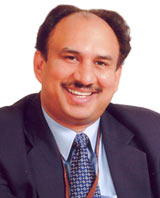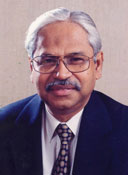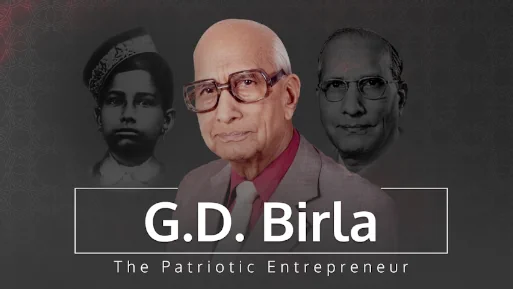The Big B of Indian Business
21 December, 2003 | Business India
Share21 December, 2003
Roshni Jayakar, additional reporting by Narendra Nathan
Business Today
The Big B Of Indian Business having grown his empire from Rs 7,200 crore to Rs 27,000 crore in eight years, Kumar Mangalam Birla is now taking it global. And having fun doing it.
Every evening for 10 days spread over last September and a part of October, Kumar Mangalam Birla left his office in Mumbai's Industry House early, making his way either to the Sophia College auditorium or the St. Andrew's Auditorium to watch a play. It was the same play, each of those days that the Chairman of the Rs 27,000-crore A.V. Birla Group sat and watched: Ramayana. A strange obsession with a Hindu mythological epic? Well, sort of. To be sure, the play was part-produced by Sangeet Kala Kendra, a Birla-sponsored cultural outfit, but there was a more important reason behind Birla's showing up every day at the auditorium. He'd promised his daughter Ananyashree (9), who was acting in the play, that he'd show up every day. And he did. It's another matter that during this period, Birla also had the small chore of snapping up a 46,000-tonne copper mine in Australia and also finally sorting out a deal-gone-messy to acquire Larsen &Toubro's cement business.
But then that's managing a behemoth, Kumar Birla style. No fuss, no hype. Yet lots of action. In the eight years since October 1995, when Birla, then 27, took charge of the biggest of the Birla empires after the untimely death of his father, Aditya Vikram, the turnover of the sprawling A.V. Birla Group has grown nearly four times-from Rs 7,200 crore to Rs 27,000 crore. Partly, that growth has come from rapid-fire acquisitions — 12 in eight years — as well as strategies to
turbo-drive existing businesses.
Remarkably, the biggest of Birla's businesses are unfashionable, at least in the contemporary sense. Cement, viscose staple fibre and yarn, carbon black, aluminium, copper and fertilisers aren't exactly stuff to get excited about but then those are the group's mainstay, making Kumar Mangalam Birla India's undisputed King of Commodities. True, Birla has made forays into new industries, like infotech consulting and software or telecom, but the group's presence there is more like that of a tentative bit player than anything else. Turn to the commodities and the story is different. The group has leveraged scale, size and efficiencies to emerge as the biggest player in most of these businesses. It is the largest producer of cement in India; it controls 45 per cent of the aluminium and 40 per cent of the copper markets; it is the market leader in insulators, viscose staple fibre and yarns and carbon black.
Staying Successful
When Birla took charge, barely three years out of business school (London Business School, class of 1992), he inherited a conglomerate of businesses that were largely quite successful. It may have seemed a bit unwieldy, particularly to institutional investors (mainly the foreign ones), weaned on theories of core competence, who felt some of the companies were too diversified. This was reflected on the bourses where stocks of group companies like Grasim and Indian Rayon faced pressures. To Birla's credit, he didn't react hastily. "After two years of studying, talking to people, getting feedback and filtering in what investors had to say, it was clear that our strengths lay in being a conglomerate. We had a track record."
The easy thing for Birla to do would have been to get out of some businesses or split his companies into entities focused on one or a few businesses rather than remain diversified. He didn't do that. He did jettison some projects (a publicly announced paper and chemicals project), close down some plants (a sea water magnesia unit in Vishakapatnam) and sell his stake in others (MRPL, a petrochemicals joint venture with HPCL). But he built on his core businesses. In cement, Birla snapped up companies and factories, growing his production capacity from 5 million tonnes in 1998-99 to 31 million tonnes now. Likewise in non-ferrous metals. Birla acquired Indal from Alcan to add to his group's already substantial interest in aluminium through flagship Hindalco. In copper, barely three years after commissioning the first smelter, the group today leads the market with a 40 per cent share — thanks in part to a restructuring of the business and takeover of two copper mines in Australia. Says Amit Chandra of DSP Merrill Lynch: "Despite the pressures he faced at the time of his taking over, he had the vision to take his key businesses to a higher level."
What made it easier for that vision to become reality was cash. In the eight years that Birla has made 12 acquisitions, the group has not tapped the capital market even once, financing every deal from internal accruals and huge cash flows from operations. In the last seven years, cash from operations at just the three big companies — Grasim, Hindalco and Indian Rayon — aggregated to more than Rs 35,000 crore (or $7.65 billion). There is, however, a niggling problem. Although most of Birla's companies are sitting on piles of cash, the promoter's stake in many of them is low. In Grasim it is less than 21 per cent; in Indian Rayon 27 and in Hindalco under 25. That could be one reason for not tapping the market as fresh capital issues could reduce the shareholding levels further. But then with healthy cash flows, who needs to tap the market?
'Context' is a word Birla likes to use often in conversation about his businesses. If his father the late Aditya Birla ran the conglomerate differently from him, it was because of a different context in which he built and managed his businesses. The senior Birla inherited plum companies from his grandfather, the legendary G.D. Birla, but grew them organically into large businesses, spotting opportunities, both in the then stringently licence-controlled Indian scenario as well as in the relatively freer markets like Egypt, Thailand, Indonesia, Malaysia and Philippines. By the time Kumar Mangalam took over, he realised that the context was changing. "India was no longer an insular economy; tariffs were coming down and you had institutional investors coming in. It became clear that we had to place our bets on fewer industries." A different context needed a new approach. Unlike his father, who'd grown his businesses predominantly through greenfield expansion, Kumar Mangalam took advantage of the consolidation in cement and metals to grow by mergers and acquisitions. Says Debu Bhattacharya, Director, BMC and CEO, Hindalco: "Our goal is to make all our businesses globally competitive."
In Step With The Times
Back in 1995, it wasn't the stockmarkets alone that were sceptical about the young Birla. Many others were prone to compare him with the towering reputation of his late father. Worse, the senior Birla's sudden demise at 52, made the first six months emotionally difficult for the newly appointed 27-year-old chairman. "While I was going through emotional turmoil, the organisation itself was in mourning." At meetings, veteran e;xecutives would frequently break down and cry at the mention of Aditya Birla's name. For the still wet-behind-the-ears chairman it was a traumatic rite of passage. Of course, the presence of senior e;xecutives — Aditya Birla's loyal lieutenants — somewhat eased this passage.
Still, the mid-nineties was an altogether different context. "The skills that were required to succeed in the nineties were very different from those of the eighties because the context had changed," says Birla. Fixing that was his biggest challenge. Around the same time that, at another similarly hoary and
tradition-bound group, Ratan Tata was grappling with the task of introducing a retirement age, Birla began doing the same. But managed it far more smoothly. His aim was straightforward and logical: he wanted the conglomerate he'd inherited to be in step with time. "Remaining contemporary is a difficult task; very few people at 60 can remain contemporary," he adds in an obvious reference to the older senior e;xecutives in the group.
Birla began the "contemporisation" of the group by inducting fresh talent at lateral and mid-levels. And simultaneously introduced a retirement age of 60. It wasn't a coincidence that one of the first senior-level recruits was a human resources specialist, Santrupt Misra, who came aboard from HLL. In the first five years, 325 people retired and at least 400 young people were hired. The average age of e;xecutives at the group was 54 in 1995; today, it's down to under 40. Says Santrupt Misra, Head of Corporate HR: "The group's HR policy has gone in for a complete overhaul with the emphasis now on adoption of globally-accepted best practices."
The new hires — as well as existing people — got more autonomy. If the senior Birla kept tabs personally on daily production at every unit, sales and cash flows, his son manages things by giving his senior e;xecutives greater autonomy and depending on CVA analyses and management information systems. When the group took over a second Australian copper mine last September, it was Hindalco's Debu Bhattacharya who led the team that clinched the deal and not Birla himself. That doesn't mean the young Birla is a hands-off manager. Only, the context has changed. When Chennai-based chartered accountant
S. Gurumurthy and swadeshi activist mediated to settle the L&;T deal, it was Birla who saw it through from the frontline, not any of his deputies. Says Bhattacharya, citing the instance of L&;T: "Once he's resolved on doing something, nothing can budge him."
Rebirth of Retro
Eight years on, Kumar Birla's recast of the group and consolidation of its businesses through acquisitions, backward integratrion and restructuring seems to have paid back. Says D.D. Rathi, Group e;xecutive President: "Grasim has been the fastest growing cement company in the last five years, while the group's VSF business has provided most of the cash." In commodity businesses like cement and aluminium, Birla has managed to guard against cyclical vagaries of the marketplace by going up the value chain. In aluminium, 60 per cent of the production is of higher value-added products. In the highly profitable insulation business, he has tied up with world leader NGK of Japan. Says Rakesh Jain, a former GE Plastics hand who has been anointed the new CEO of Indo-Gulf Fertilisers: "We are well-positioned to weather any uncertainty, including decontrol of the sector." One of the outcomes has been a re-rating of stocks of the group's larger companies. Grasim, on the strength of its cement business, trades at a P-E of 17.75 (compared to 9.7 in 1995) and Hindalco at 20.5 (11.2 in 1995). Says Manish Chokhani, Director, Enam Securities: "The market has factored in the organisational changes and re-rated the group's stocks."
Birla is easily the Big B of India Inc's old economy. True, there are others with big ambitions in commodity-oriented businesses — like Sterlite's Anil Agarwal, who straddles the non-ferrous metals market and has global ambitions — but Birla's sheer dominance across a swathe of commodities is difficult to match.
The same cannot be said of his other businesses. Like most Indian big industrial groups, Birla too has forayed into new and emerging industries. In sharp contrast to his commodities empire, they are still small and in some instances not very successful. His infotech ventures are tiny in comparison to the biggies in the industry; his presence in telecom is more through a financial stake in IDEA Cellular rather than pro-active; and a slew of joint ventures in financial services like mutual funds and insurance are still in their formative stages. Plus, although the takeover of Madura Garments in 2000, gave him a headstart in the branded apparel market, competition in that segment is ever increasing. He's also made tentative entries into entertainment and media (including an aborted move for a joint venture with Star TV).
Birla defends some of these not-so-successful ventures as "testing the waters" and others — like his BPO and it businesses — as ones that could well prove to big in the long haul. He's not quite sure his group will look too different in the next five or even 10 years, at least in terms of portfolio but he's very sure that it'll be quite different in terms of size. "I'm convinced that we (the group) have all that it takes to be in the Fortune 500 by the turn of the decade. Is that impressive enough?" For a group placing its bets unabashedly on the old economy, it sure is.
Birla's A-Team
Over the past five years, Birla has managed to build a core team of pros he can bank on.
 |
Santrupt Misra |
|
Saurabh (Chandu) Misra |
|
 |
Debu Bhattacharya |
|
Shailendra Jain |
|
 |
Sanjeev Aga |
|
S.K. Mitra |
|
 |
M.C. Bagrodia |
|
Bharat K. Singh |
|






